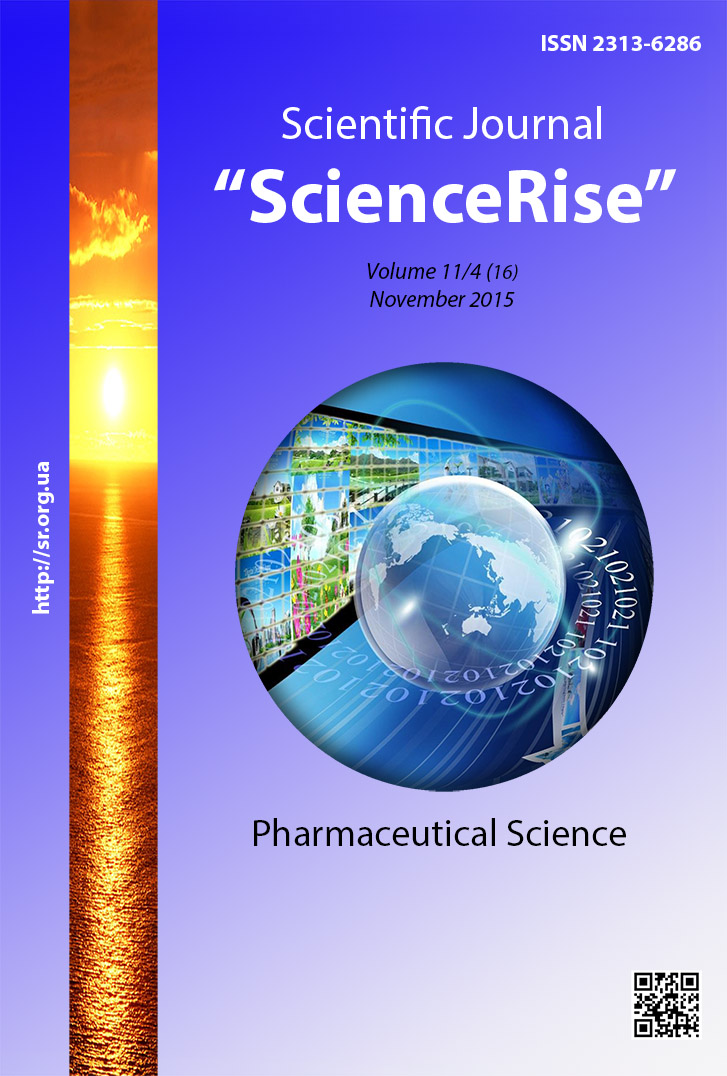Аналіз фармацевтичного ринку ноотропних засобів в Україні
DOI:
https://doi.org/10.15587/2313-8416.2015.54873Ключові слова:
аналіз, фармацевтичний ринок, Україна, ноотропні препарати, рослинні засоби, номенклатура препаратівАнотація
Захворювання нервової системи посідають одне з провідних місць у структурі захворюваності та смертності в усьому світі. За даними ВООЗ, близько 30 % населення регулярно приймають нейротропні засоби. Для осіб літнього віку, чия питома частка в сучасному суспільстві неухильно зростає, цей показник складає близька 50 %. Проте слід відзначити і збільшення частоти захворюваності нервової системи і у осіб молодого віку. Дані факти свідчать про актуальність та затребуваність лікарських засобів даної групи, зокрема, ноотропних препаратів, які найчастіше застосовуються при лікуванні нервових захворювань.
Ціль. Метою даної роботи було проведення аналітичного огляду фармацевтичного ринку ноотропних засобів в Україні.
Методи. Статистичні і маркетингові методи досліджень електронних і паперових джерел інформації. Об'єкт дослідження – інформація про зареєстровані в Україні ноотропні лікарські засоби.
Результати. Встановлено, що вітчизняні фармацевтичні препарати займають 57 % ринку ноотропних засобів. В Україні представлені 16 країн-виробників ноотропних препаратів. Дослідження ринку ноотропних препаратів показало, що вони представлені в різних лікарських формах (таблетки, капсули, сиропи, пілюлі, суспензії, розчини для ін'єкцій, розчини для інфузій, розчини для перорального застосування, порошок дозований у пакетах), серед яких переважають таблетки.
Висновки. Ноотропні препарати синтетичного походження переважають і займають 87 %, частка рослинних засобів – 13 %, які характеризуються одноманітністю складу і представлені лише препаратами гінкго білоба. Результати щодо співвідношення форм випуску засвідчують, що рослинні препарати ноотропної дії найбільше представленні у формі таблеток 67 %
Посилання
Avedisova, А.S., V. І. Ahapkin (2001). Analysis of foreign investigations of nootropic drugs. Russian Psychiatric Journal, 1, 57–63.
Damulin, I. V. (2002). Alzheimer's disease and vascular dementia. Moscow, 85.
Grundman, M. (2001). Current therapeutic advances in Alzheimer's disease. In: Research and practice in Alzheimer's disease. Vol. 5. Springer Publishing Company. New York, 172–177.
Yachno, М. М., I. V. Damulin, I. S. Preobragenska, Е. А. Mhitayan (2003). Alzheimer's disease and dementia with Lewy bodies: some aspects of clinic, diagnostics and treatment. Мedical journal, 11 (10), 567–570.
Burchinsky, S. G. (2002). Pramiracetam is a nootropic drug of new generation from pharmacology to clinic. Ukrainian medicinal products, 3-4, 1–8.
Vinnichuk, S. М. (2006). Oxidative stress at acute ischemic stroke and its correction by antioxidant mexidol. International journal of neurology, 4, 45–52.
Korshunov, А. М., Preobragenska, I. S. (1989). Programmed cell-death (apoptosis). Journal of Neurology, 1, 40–47.
Preobragenska, I. S., Jahno, M. M. (2002). Alzheimer's disease: pathogenesis, clinic, treatment. Мedical journal, 10 (25), 1143–1147.
Putilina, М. V. (2006). Modern understanding about nootropic drugs. Physician in charge: Journal for practitioner, 5, 10–14.
Mashkovsky, M. D. (2008). Drug products. Мoscow: New wave, 1206.
Bullock, R. (2002). New drugs for Alzheimer's disease and other dementias. The British Journal of Psychiatry, 180 (2), 135–139. doi: 10.1192/bjp.180.2.135
Avarez, X. A., Ruether, E., Moessler, H. (2001). Efficacy of cerebrolysin in moderate to moderately severe Alzheimer's disease. In: Research and practice in Alzheimer's disease. Vol. 5. Springer Publishing Company, New York, 179–186.
List of nootropic drugs, approved for usage in Ukraine (2011). Ukrainian medicinal products, 4 (150), 132–135. Available at: http://nbuv.gov.ua/j-pdf/likukr_2011_4_26.pdf
Chernykh, V. P. (Ed.) (2010). Pharmaceutical encyclopedia. Kyiv: "Morion", 1632.
Specific medical online media for doctros, pharmaceutists, pharmacists, students of medical and pharmaceutical HEIs. Compendium. Drug products on-line. Available at: http://compendium.com.ua
##submission.downloads##
Опубліковано
Номер
Розділ
Ліцензія
Авторське право (c) 2015 Олена Валеріївна Савельєва, Інна Миколаївна Владимирова, Ганна Сергіївна Шумова

Ця робота ліцензується відповідно до Creative Commons Attribution 4.0 International License.
Наше видання використовує положення про авторські права Creative Commons CC BY для журналів відкритого доступу.
Автори, які публікуються у цьому журналі, погоджуються з наступними умовами:
1. Автори залишають за собою право на авторство своєї роботи та передають журналу право першої публікації цієї роботи на умовах ліцензії Creative Commons CC BY, котра дозволяє іншим особам вільно розповсюджувати опубліковану роботу з обов'язковим посиланням на авторів оригінальної роботи та першу публікацію роботи у цьому журналі.
2. Автори мають право укладати самостійні додаткові угоди щодо неексклюзивного розповсюдження роботи у тому вигляді, в якому вона була опублікована цим журналом (наприклад, розміщувати роботу в електронному сховищі установи або публікувати у складі монографії), за умови збереження посилання на першу публікацію роботи у цьому журналі.

